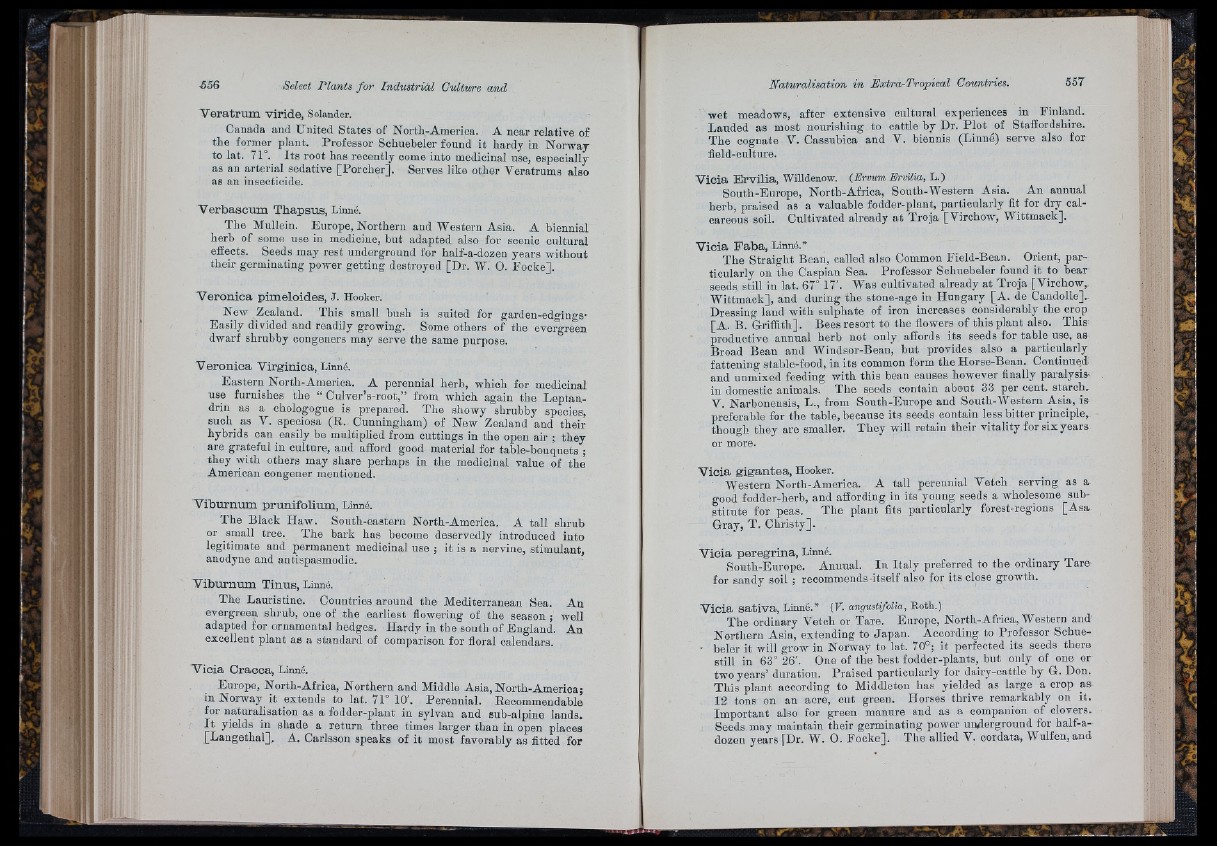
Veratrum. viride, Solander.
Canada and United States of iSiortli-America. A near relative of
the former plant. Professor Sohuebeler found it hardy in Norway
to lat. 71°. Its root has recently come into medicinal use, especially
as an arterial sedative [Porcher]. Serves like other Veratrums also
as an insecticide.
Verbascum Thapsus, Linné.
The Mullein. Europe, Northern and Western Asia. A biennial
herb of some use in medicine, but adapted also for scenic cultural
effects. Seeds may rest underground for half-a-dozen years without
their germinating power getting destroyed [Dr. W. C. Focke].
Veronica pimeloides, J. Hooker.
New Zealand. This small bush is suited for garden-edgings-
Easily divided and readily growing. Some others of the evergreen
dwarf shrubby congeners may serve the same purpose.
Veronica Virginica, Linné.
Eastern North-America. A perennial herb, which for medicinal
use furnishes the “ Culver’s-root,” from which again the Leptan-
drin as a chologogue is prepared. The showy shrubby species,
such as V. speciosa (R. Cunningham) of New Zealand and their
hybrids can easily be multiplied from cuttings in the open air ; they
are grateful in culture, and afford good material for table-bouquets ;
they with others may share perhaps in the medicinal value of the
American congener mentioned.
Viburnum prunifolium, Linné.
The Black Haw. South-eastern North-Amerioa. A ta ll shrub
or small tree. The bark has become deservedly introduced into
legitimate and permanent medicinal use ; it is a nervine, stimulant,
anodyne and antispasmodic.
Viburnum Tinus, Linné.
The Lauristine. Countries around the Mediterranean Sea. An
evergreen shrub, one of th e earliest flowering of the season ; well
adapted for ornamental hedges. Hardy in the south of England. An
excellent plant as a standard of comparison for floral calendars.
Vicia Cracoa, Linné.
Europe, North-Afriea, Northern and Middle Asia, North-America;
in Norway it extends to lat. 71° 10'. Perennial. Reeommendable
for naturalisation as a fodder-plant in sylvan and sub-alpine lands.
I t yields iu shade a return three times larger than in open places
[Langethal], A. Carlsson speaks of it most favorably as fitted for
wet meadows, after extensive cultural experiences in Finland.
Lauded as most nourishing to cattle by Dr. Plo t of Staffordshire.
The cognate V. Cassubica and V. biennis (Linné) serve also for
fleld-culture.
Vicia Brvilia, Willdenow. {Ervum Ervilia, L .)
Sonth-Europe, North-Africa, South-Western Asia. An annual
herb, praised as a valuable fodder-plant, particularly fit for dry calcareous
soil. Cultivated already a t Troja [Virchow, Wittmack].
Vicia Paba, Linné.*
The Straight Beau, called also Common Field-Bean. Crient, particularly
on the Caspian Sea. Professor Sohuebeler found it to bear
seeds still in lat. 67° 17'. Was cultivated already a t Troja [Virchow,.
Wittmack], and during the stone-age in Hungary [A. de Candolle]..
Dressing laud with sulphate of iron increases considerably the crop
[A. B. CrifRth]. Bees resort to the flowers of this plant also. This
productive annual herb not only affords its seeds for table use, as
Broad Bean and Windsor-Bean, hut provides also a particularly
fattening stable-food, in its common form the Horse-Bean. Continued
and unmixed feeding with this bean causes however finally paralysis
in domestic animals. The seeds contain about 33 per cent, starch.
V. Narbonensis, L., from South-Europe and South-Western Asia, is
preferable for the table, because its seeds contain less bitter principle,
though they are smaller. They will retain their vitality for six years
or more.
Vicia gigantea, Hooker.
Western North-America. A tall perennial Vetch serving as a
good fodder-herb, and affording in its young seeds a wholesome substitute
for peas. The plant fits particularly forest-regions [Asa
Gray, T. Christy].
Vicia peregrina, Linné.
South-Europe. Annual. In Ita ly preferred to th e ordinary Tare
for sandy soil ; recommends itself also for its close growth.
Vicia sativa, Linné.* (V. angustifolia, Roth.)
The ordinary Vetch or Tare. Europe, North-Africa, Western and
Northern Asia, extending to Japan. According to Professor Schue-
• beler it will grow in Norway to lat. 70°; it perfected its seeds there
still in 63° 26'. Cne of the best fodder-plants, but only of one or
two years’ duration. Praised particularly for dairy-cattle by G. Don.
This plant according to Middleton has yielded as large a crop as-
12 tons on an acre, cut green. Horses thrive remarkably on it.
Important also for green manure and as a companion of clovers..
Seeds may maintain their germinating power niffierground for half-a-
dozen years [Dr. W. O. Focke]. The allied V. oordata, Wulfen, and